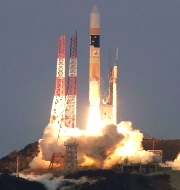Japan successfully launches space junk collector into orbit
Japan’s space agency (JAXA) successfully launched a Kounotori 6 (HTV-6) spacecraft that will deliver a large magnetic tether, a space junk collector technology into orbit.
The spacecraft was launched on board of H-IIB rocket from Tanegashima Space Center. It was also carrying essential supplies for International Space Station (ISS).
Key Facts
- The space junk collector (electromagnetic tether) will perform Kounotori Integrated Tether Experiments (KITE) in order to test out new technology.
- It is an experimental space scavenger that aims to study possibility of getting rid of space junk (debris) left into orbit by earlier space exploration missions.
- It has been designed by JAXA engineers in collaboration with Nitto Seimo Co., a Japanese fishing net company.
- The space scavenger is large magnetic tether made from thin wires of stainless steel and aluminium. It is designed to redirect space junk towards Earth’s atmosphere.
- In theory, the net-like tether will generate enough slowing effect to influence the trajectory of space debris toward Earth’s atmosphere where they will burn up.
Why there is need of space junk collector technology?
More than 5 decades of human space exploration since the first Soviet-launched Sputnik satellite in 1957 has produced this hazardous belt of orbiting debris in the space. There are estimated to be more than 100 million pieces are circling our planet in the lower orbit, posing a growing threat to future space exploration. These pieces of debris travel at high speeds. A relatively small piece of orbital debris can inflict a great deal of damage on satellites or spacecrafts orbiting in the space. This phenomenon is Kessler Syndrome which describes a self-sustaining cascading collision of space debris in low earth Orbit.
Month: Current Affairs - December, 2016


